|
 |
 |
 |
|
Arctic
terns (Sterna paradisaea). Arctic terns have the longest
yearly migration of any bird species, with some individuals covering
~80,000
km annually. Metals and other contaminants accumulated over their long
journeys are ultimately deposited near their nesting sites, in some
instances to toxic concentrations. Image courtesy of Mark Mallory.
|
A nesting
Arctic tern (Sterna paradisaea). Most Arctic terns return to
the same area, and often the same colony, from where they were hatched.
Sediment cores from ponds that drain nesting areas provide a means to
track long-term population dynamics because wastes from the colony (ie,
guano, carcasses, eggshells) impart a unique geochemical signature to
the pond sediments. Image courtesy of Mark Mallory. |
A breeding pair of common eider
ducks (Somateria mollissima). The male has distinctive black and
white plumage with a green nape, whereas the female is brown. Eiders
nest on coastal islands in colonies that range from less than 100 to
upwards of 10,000 individuals. By feeding in the ocean, but nesting on
land, eiders transport and focus marine-derived nutrients and
contaminants to terrestrial ecosystems. Image courtesy of Mark Mallory. |
|
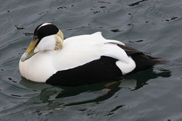 |
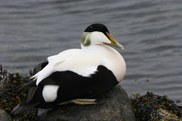 |
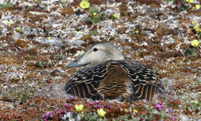 |
|
Male common eider (Somateria
mollissima) with its distinctive black and white plumage and green
nape. The common eider is the largest duck in the northern hemisphere
with adult males reaching up to 3 kg. Waste products released from eider
colonies leave distinct biogeochemical signatures in soils and ponds
sediments located near their nesting sites and can be used to infer
population dynamics and identify long-term breeding habitats. Images
courtesy of Mark Mallory. |
Male common eider (Somateria
mollissima) with its distinctive black and white plumage and green
nape. The common eider is the largest duck in the northern hemisphere
with adult males reaching up to 3 kg. Waste products released from eider
colonies leave distinct biogeochemical signatures in soils and ponds
sediments located near their nesting sites and can be used to infer
population dynamics and identify long-term breeding habitats. Images
courtesy of Mark Mallory. |
Female common eider (Somateria
mollissima). Eiders are capable of diving up to 20 m to obtain their
prey, which consists primarily of mussels, clams, scallops, sea urchins,
starfish and crabs. Their diet largely determines the degree to which
they will accumulate different environmental contaminants such as
metals, which ultimately are released to the terrestrial environment
near their nesting sites, via excrement and other waste products. Image
courtesy of Mark Mallory. |
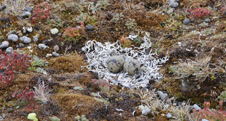 |
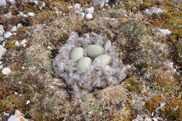 |
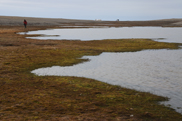 |
|
Arctic tern (Sterna
paradisaea) eggs. The harvesting of tern eggs, or egging, for
subsistence living still occurs in some regions of the Arctic and may
have contributed to the decline of some local bird populations. Sediment
cores from ponds located near tern colonies may be used to infer
long-term population dynamics because waste products from the terns
leave distinct biogeochemical signatures that reflect past population
numbers as well as contaminant loads of the birds themselves. Image
courtesy of John Smol. |
Common eider (Somateria
mollissima) eggs, shown in a nest of the renowned eider down that is
much sought after as one of the lightest and most effective insulators.
Sediment cores from ponds located near eider colonies may be used to
infer long-term population dynamics because waste products from the
eiders leave distinct biogeochemical signatures that reflect past
population numbers as well as contaminant loads of the birds themselves.
Image courtesy of John Smol. |
Eider Pond, shown here, is
located in the central portion of Tern Island and is surrounded by
approximately 50-100 common eider hens. (source: John P. Smol, Queen’s
University). |
|
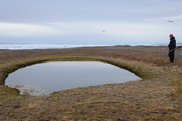 |
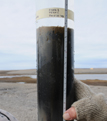 |
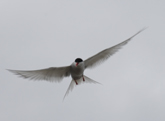 |
| Tern Pond,
shown here, is located in the eastern portion of Tern Island and is
surrounded by approximately 300 pairs of nesting terns. The closeness of
Tern and Eider ponds to one another (about 1 km) minimizes any
variability related to differences in climate, geology and atmospheric
precipitation between the two study sites. This provides a rare
opportunity to compare and contrast the impacts of different seabird
species on freshwater habitats. (source: John P. Smol, Queen’s
University). |
Sediment
cores, such as this one recovered from Eider Pond, can be used to
track past seabird inputs over long-term timescales because seabird
wastes leave distinct geochemical signatures that reflect contaminant
loads and even differences in diet. (source: John P. Smol, Queen’s
University). |
In flight
photograph of an Arctic tern (Sterna paradisaea). (source: John P.
Smol, Queen’s University) |
|
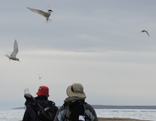 |
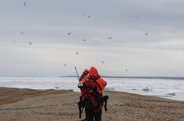 |
 |
|
Arctic terns (Sterna
paradisaea) flying
overhead during the sampling of Tern Pond. The use of helmets and
protective head gear was necessary during sampling of the pond, because
terns will aggressively defend their nests from any perceived predators.
(source: John P. Smol, Queen’s University). |
Arctic
terns (Sterna paradisaea) flying overhead during the sampling
of Tern Pond. The use of helmets and protective head gear was necessary
during sampling of the pond, because terns will aggressively defend
their nests from any perceived predators. (source: John P. Smol, Queen’s
University). |
The
remoteness and small size of Tern Island greatly minimizes the
numbers of terrestrial predators such as the Arctic fox; however, the
nesting seabirds must be wary of attacks from aerial predators such as
this long-tailed jaeger (Stercorarius longicaudus). (source: John
P. Smol, Queen’s University). |
